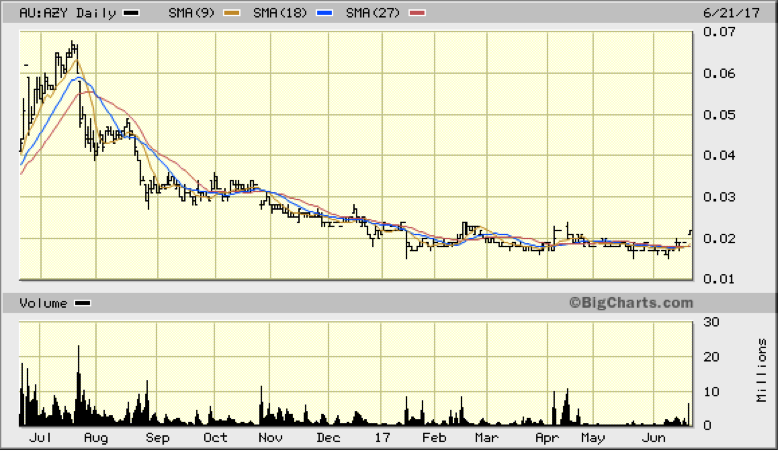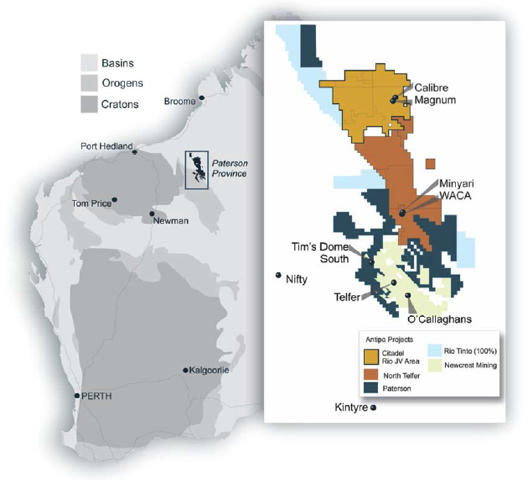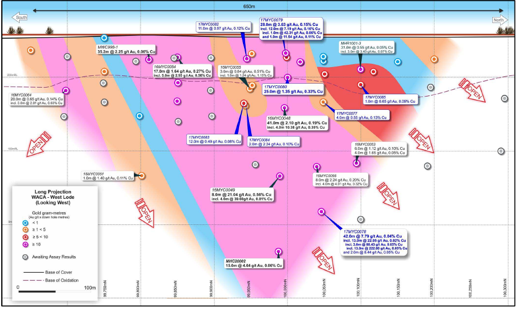Antipa Minerals (ASX: AZY, Share Price: $0.022, Market Cap: $26m) maintains a first-class acreage position within the mineral-rich Telfer province of Western Australia – a fact reflected in the lucrative agreement with mining behemoth Rio Tinto Exploration, which allows for Rio to spend up to $60 million on exploration and appraisal of Antipa’s Citadel gold and copper project within the Telfer region.
As a follow up to last week’s coverage where we announced Antipa had commenced Phase 1 of the Citadel Project 2017 calendar year exploration program, Antipa has announced highly encouraging high-grade gold drilling results that include 42.0 metres at 7.8 g/t Au from 262 metres down-hole depth.

Market Significance
Antipa’s share price is up 22% in this week’s trade on the back of the release of today’s high-grade drilling results at Minyari Dome WACA. The high‐grade mineralisation at WACA from near-surface highlights its open-pit potential, with the mineralisation remaining open along strike to the north and south – and at depth. The overall objective of the 2017 drilling program is to enable the company to establish a maiden JORC Mineral Resources as part of a Scoping Study to examine the economic potential of the Minyari Dome by the end of 2017. We await the release of further drilling results with great interest.
Announcement Detail – Citadel Project Update
In last week’s coverage we advised that Antipa had commenced Phase 1 of its Citadel Project 2017 exploration program, which is being fully funded by Rio Tinto. The Phase 1 funding is part of Rio Tinto’s $8 million earn‐in expenditure, pursuant to the second stage of the Citadel Project farm‐in agreement between Rio Tinto and Antipa.

Latest Results
Antipa has since advised that high‐grade gold mineralisation has been intersected at its Minyari Dome WACA deposit from near surface, with the best (uncut) results including 42.0 metres at 7.8g/t Au from 262 metres down-hole depth in hole 17MYC0078 – including 13.0 metres at 22.1 g/t Au and 1.0 metre at 222.0 g/t Au. Hole 17MYC0079 also intersected 28.0 metres at 3.6 g/t Au (uncut) from 13 metres down-hole, including 12.0 metres at 7.2 g/t Au. To date assays have been received for 21 drill-holes (including one abandoned drill hole), representing approximately one‐third of the expanded 2017 Phase 1 program.
WACA Deposit
Results have been received for 10 (total 1,830 metres) of 49 RC drill-holes (total 6,671 metres), testing for high-grade gold shoots along up to 550 metres of strike and down to 300 metres depth. These drill-holes have provided several very significant high‐grade gold intersections from near-surface, highlighting the open pit potential of the WACA deposit and reinforcing the exceptional exploration potential of the Minyari Dome area. The delineation of these high to very high-grade WACA gold ore shoots could reasonably be expected to lead to the delineation of a high‐grade Mineral Resource at WACA.

Figure 1: WACA Deposit Long Section showing drill holes, including 2017 Phase 1 RC drill-hole pierce points along a 650m strike length of the WACA gold mineralisation zone (100m Local Grid – looking west).
Minyari Deposit
Results have been received for 11 (total 1,485 metres) of 15 (total approximately 2,600 metres) RC drill-holes testing strike extension targets, including a 150m – 200m corridor northwest and a +100m corridor to the southeast of the Minyari main central zone. The results have provided encouraging gold, copper, cobalt and arsenic intersections, resulting in this component of the planned Phase 1 program being expanded from 11 to 15 RC drill holes, several of which are yet to be drilled.
Technical Significance
The high‐grade mineralisation at WACA from near-surface highlights its open-pit potential, with the mineralisation remaining open along strike to the north and south – and at depth. The results highlight the development and exploration potential of the Minyari Dome and the company’s 4,400 sq km Paterson Province exploration portfolio.
Next Steps
The overall objective of the 2017 drilling program is to establish a maiden JORC Mineral Resource as part of a Scoping Study to examine the economic potential of the Minyari Dome by the end of 2017.
The 2017 program is being carried out in two phases, with the first phase originally planned to involve up to approximately 9,000 metres of RC drilling at the Minyari and WACA gold‐copper deposits, as well as additional selected targets. Due to the encouraging interim results announced today, Antipa has decided to expand Phase 1 to approximately 60 drill-holes for 12,000 metres and is scheduled to be completed later this month. Phase 2 will be formulated following the evaluation of the results of Phase 1.
Summary
We initiated coverage of Antipa Minerals around $0.024 during October 2015.
The company is already well advanced in terms of its exploration status, boasting a sizeable 1.6M gold-eq oz JORC-compliant resource. There’s little doubt the resource will continue to grow, so it now becomes a question of scale, grades and potential development economics. It’s fair to say that the market had hoped that progress would have been somewhat more rapid in this regard, which explains the mediocre share price performance over the past 12 months.
The Rio farm-in deal nevertheless provides near-term funding certainty and also ensures active exploration. The Rio JV reflects the underlying resource potential of the Citadel project, which lies just 75km north of Newcrest’s Telfer gold-copper-silver deposit. Simultaneously, the company is well funded to continue exploration work on its own 100%-owned projects.







